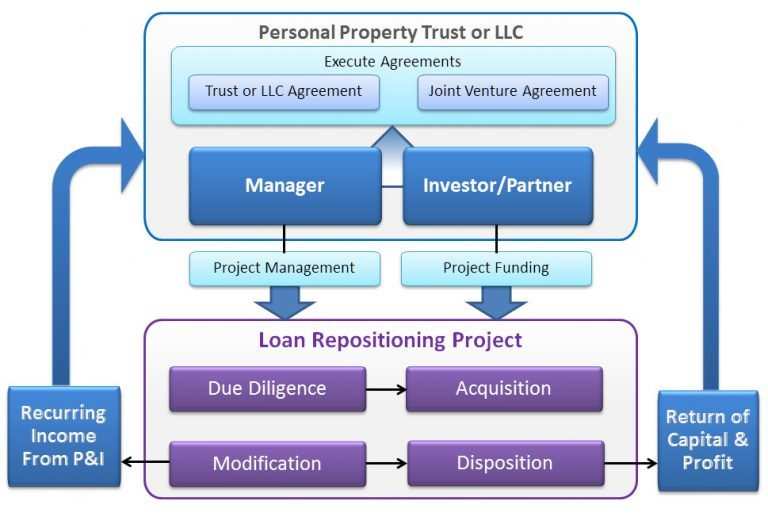Joint Venture Opportunity Submit From Now

A typical practice in structuring Mortgage note real estate transactions is a joint venture between two parties:
Party A, commonly known as the Sponsor, Operator or General Partner/GP, makes day-to-day property level decisions, oversees the property manager, supervises improvement projects and generally executes the on-the-ground aspects of a business plan.
Party B, commonly known as the Limited Partner/LP, provides most of the equity capital necessary to fund the acquisition and any planned value-add strategy.
The idea here is simple. The LP relies on the GP’s expertise in executing the business plan. Now, if you were the GP putting in sweat equity so the LP can enjoy passive returns, you likely won’t work for free!
Let’s introduce a variety of methods commonly used to compensate the GP for its sweat equity and operational oversight.
Transaction Fees
Origination/Acquisition Fee: As simple as it sounds, this is generally calculated as a percentage of the purchase price and for the most part ranges from 0-2%.
Financing Fee: Not as common as acquisition fees, but still found in the wild. For the most part, ranges from 0-1% and is calculated as a percentage of the initial loan balance.
Disposition Fee:
GP: “Hey, we sold the asset.”
LP: “Great! How much did we make?”
GP: “I haven’t calculated that yet, but we sold it, so that will be 1% of the sale price please.”
Management Fees
Asset Management Fee: This one can vary, but is usually either a fixed monthly dollar amount, a percentage of revenues, or a percentage of the equity capital invested. The idea here is to compensate the GP for dedicating its employees and time to managing the asset. Note: This is NOT a property management fee, which we’ll assume is a 3rd party provider, but rather means overseeing strategy, leasing, reporting, etc.
Construction Management Fee: If there is renovation work to be done, or tenant improvements, or other capital expenditures, and your property manager is not tasked with overseeing the work (or sometimes, even if they are), you’ll find sponsors asking for this fee. What’s reasonable? It depends, but imagine a sliding scale from 1-5% depending on the size of the work necessary (smaller jobs -> higher percentages).
Leasing Fee: You’ll also find sponsors asking for this even if there are 3rd party leasing agents on the assignment. Why? The why behind any of these fees is, because they can, and because LPs don’t ask. Especially smaller groups of LPs with less negotiating leverage.
Profit Sharing/Waterfall/Incentive Fee
Assume for a moment that of the equity required for a given investment, 90% of it comes from the LP, and 10% comes from the GP. How should distributions be split? 90/10?
Well, actually, a very common profit-sharing agreement in real estate joint ventures comes in the form of an uneven sharing of cash flows. For example, equity might be invested 90/10, but distributions could be split 70/30.
“That’s not fair” an investor might say, and that investor is probably right. Which is why we find a practice called the “waterfall.” The waterfall, or incentive fee, is a profit-sharing mechanism in which profits are shared unevenly, but only above a specified minimum return on the investment. Which is to say, an investor is happy to share more profits with the Sponsor, but only if they have received a 10% return on their capital, for example.
What is a standard waterfall? Wish we could tell you. It’s one of the most negotiated items in a joint venture, that range from obscene (huge profit share to operating partner, low return hurdle) to quite reasonable (investor receives solid return and thereafter shares a portion of the returns). In any case, a waterfall is money out of the LP’s pockets had they executed the transaction directly without an operating partner.
Sowing Confusion – Shedding Light to Hidden Fees
The summary is that LP’s pay for the benefit of not doing the work themselves. What they pay and how much they pay, as you can see, varies greatly. And hopefully, YOU, the investor, are informed enough to be able to ask the proper questions. But there are ways to hide fees! And unless one knows where to look, the LP investors are charged these fees without even knowing about it.
It all comes back to the joint venture format. Are you investing with the real estate operator directly, or are you investing with a firm/website that aggregates investor capital, and subsequently invests with a real estate operator? I hate to tell you this, but it’s likely the former (unlike Streitwise, where you’re investing directly with the operator).
Why is this distinction important? Because it means that the company you’re investing with (let’s call them the Aggregator) can tell you “Hey, we don’t charge acquisition fees” or “No profit sharing waterfall here” all the while misleading you that the real estate operator that ultimately manages the asset does charge those fees.
An example of how fee structures can be manipulated to look lower to retail investors than they actually are.
Scenario: A property is acquired for $30mm through a combination of $20mm of debt and $10mm equity.
Aggregator fees: You invest with a group, let’s call them Aggregator, who charges an asset management fee of 1% a year on equity and raises a total of $9mm.
Aggregator – sponsor relationship: Aggregator then takes that capital and invests in a joint venture with the sponsor, who contributes $1mm of equity.
Sponsor fees: Suppose sponsor charges a 2% acquisition fee (a one-time fee of $600K), a 1% financing fee (a one-time fee of $200K) and an annual 1% asset management fee ($100K per year).
Aggregator & sponsor profit sharing: Suppose further that the cash flows are split 50% to Aggregator and 50% to sponsor.
Result: That’s $800K right off the top, $100K per year, and 50% of the upside that will NOT flow to the investors who invested with the Aggregator. And yet, the Aggregator can still claim that they only charge fee a 1% management fee. The joint venture hides fees! No matter how you slice it, fees paid to an operator, even if you are not investing directly with them, is money out of an investor’s pocket. If it weren’t for that fee, the money would be available for you.
We have established a safe and ethical platform through which a capital investor can partner on multiple types of residential investments for a minimum of $120,000. Important to note, that through our process, there are no co-mingling of funds and real estate is separated from notes to limit liability through protected series LLC’s.
We do all the workouts and have excellent communication tools to illustrate how each investment is performing.
NON PERFORMING LOANS: We offer 60/40 splits to our investors, where the investor get 60% of the net profits and we get 40%.
PERFORMING LOANS: We offer a preferred rates of up to 8.5% on performing loans and a 50/50 split upon disposition.
FIX & FLIPS: We will rehab the project for a 50/50 split of the net profits at disposition.
